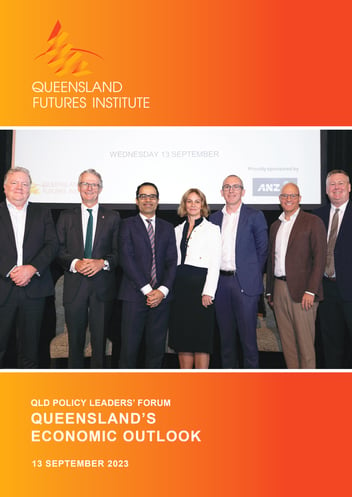|

|
Jo Masters
- The economic environment across Queensland and Australia remains complex after a challenging few years, both from a cyclical and a structural perspective.
|

|
Michael Anthonisz
- From the recent state budget, the outlook for Queensland holds several
opportunities and risks for the state over the years ahead. Queensland Treasury has forecasted Queensland’s Gross State Product to accelerate over the next few years, from 2% this year to 3% in each of the next two financial years.
- This reflects the normalisation of interest rates. That is, as interest rates come
down, they will no longer weigh on household spending as much as they currently do. Additionally, we may potentially see tax cuts at the federal level and the unwinding of supply chain disruptions which have weighed on housing construction and the state’s export sector.
- This is a cautiously optimistic forecast of the next few years from Queensland
Treasury. It also indicates growth rates which are slightly above the average since
the Global Financial Crisis, and roughly in line with the national average.
- There will also be a number of opportunities to bolster this growth, the most
significant of which is our trade relationship with India. India is currently
Queensland’s second largest trading partner and it doesn’t require a huge leap in imagination to see it becoming the largest in the coming years. This opportunity is significant for Queensland given India’s geographical proximity, its favourable demographic underpinnings, and the scale of the industrialisation and urbanisation that is currently underway.
- A key strength for Queensland in recent decades has been our population story.
Over the past 40 years, Queensland’s share of the national population has
increased from 15% to 20%. Our share of the national economy also increased from 15% to 20% over the past 30 years, indicating the correlation between our relative population, performance, and economic outperformance.
- This relationship will likely continue, as there are no constraints which would
structurally change this dynamic. However, the Commonwealth Government’s
National Centre for Population projects that over the next decade, Queensland’s
share of the national population will flatline, rather than continue to increase. If this eventuates, then we need other things to fall our way in order to continue to grow our share of the national economic pie. These may include higher commodity prices or finding ways to be more productive than other states. These sorts of outcomes are inherently uncertain however, a key challenge going forward will therefore be the planning required if the tailwind of population growth ceases.
|

|
Simon Lewis
- Australian consumers have been surprisingly resilient to the recent economic
challenges. As interest rates have risen by 400 basis points over the last 12-18
months, consumer confidence has declined. However, at an individual level, people have been finding ways through this period, for example, by using cash saved over Covid. Since we are only 60% through the fixed rate cliff, we will see this start to reduce even further, particularly by the first quarter of next year.
- Most current mortgage borrowers have qualified for a mortgage at an interest rate of at least 5.5%. So, while the cost-of-living shock has been considerable, the actual shock we should be wary of is the difference between this amount and perhaps 6% that people are now paying on their variable rate mortgages.
- Investors are cautiously optimistic in the current conditions. There are a number of concerns and challenges – including around rental reforms currently underway and the possibility of impending drought and the potential impacts on our communities is another cause for concern in the near future.
|

|
Richard Yetsenga
- The balance sheet of the Australian household sector has never been this strong.
We have handled higher rates quite well because our net asset position is the best we have ever seen. While this has slightly deteriorated with the decline in house prices relative to the peaks of 24 months ago, we expect the household sector to continue in pretty good shape.
- As we undertake the climate transition, Australia is one of the few economies which not only was a beneficiary through the export side of a fossil fuel driven global energy system, but also has the minerals required to deal with the transition. This creates a massive opportunity in the coming years, which will require the right policy settings to achieve. But we are also delivering into these challenges with a very strong labour market. Unemployment is at 50-year lows and female participation is at the highest level we’ve ever seen.
- One of Queensland’s strengths has been our demographic story. This is closely
linked with housing affordability, which will remain a challenge to sustain.
- Finally, Queensland’s strong trade position and relationship with China is another
area of opportunity and challenge in the coming years. China’s slowing regional
activity may persist in the next couple of decades, relative to previous decades.
While it is still an $18 trillion economy, we will start to transition the export sector to diversify trade partners. Additionally, we will need to deal with the trade cycle and the global transition from fossil fuel towards different forms of energy
|

|
Anthony Rose
- Australian Retirement Trust manages about $260 billion of the retirement savings
of over 2.2 million members, around 70% of which is based here in Queensland
given our heritage in QSuper and Sunsuper (prior to the merger to form Australian Retirement Trust). Of over 3,000 employees, 2,500 are Brisbane-based. We are also the largest custodian of superannuation funds for women in the country.
- Looking at the macroeconomic environment, we have recently seen an abatement in the supply chain issues that have persisted over the recent years. While inflation seems to have stabilised and moderated, central banks are now looking at wage inflation and how this may later impact the rate cycle. However, we have recently seen a slight increase in unemployment in the US to 3.8% - last at this level in February 2022. This is a possible sign of easing inflationary pressures.
- Equity markets are currently optimistic on the global economic outlook, but there are a number of drivers which should be considered around this. Firstly, there is a broad push post-Covid towards de-globalisation, particularly given the current geopolitical environment. This is reflected in a strong focus on building business resiliency and redundancy, identifying the concentration risks in end-to-end business models, and diversifying away from these risks. This will be a multi-decade journey, shifting the allocation of capital and how our end-to-end systems function.
- Secondly, there is significant movement around the Unites States’ Inflation
Reduction Act (IRA). This is effectively a series of tax reforms, driving the
decarbonisation of the U.S. economy and putting USD$800 billion into related
initiatives. This money is starting to have real impacts, flowing through to the
balance sheets of the industries that are driving decarbonisation. The employment and economic activity this drives will be significant.
- Comparing the IRA to other macroeconomic policies, this reform may actually
contribute to the stability of the US market, as it could be argued that this is similar to the quantitative easing of the GFC and the spending through Covid measures.
|

|
Garnett Hollier
- Brighter Super are a $31 billion asset owner based here in Queensland since 1965.
- Inflation is at the forefront of investment decisions we take, given its impacts on
purchasing power for our fund members. We returned 10.62% for our members last year and remain focused on the economic environment ahead. There are headwinds around the uncertainty of inflation, interest rates or potentially a recession, which we must respond to appropriately through the allocation of our assets.
- To do this, we believe in the strength of the Queensland economy, having about a
billion dollars in unlisted infrastructure and property here. We allocate to earn best risk adjusted return globally. So having a fifth of our global infrastructure allocation in Queensland and about a quarter of our global property allocation in Queensland indicates our high conviction relative to other opportunities.
- We are also well positioned to do more in Queensland. It’s a key part of our
strategy to build a tangible connection between our assets, our members and
the communities that they live and work in. We recently acquired Suncorp
Superannuation Fund, which has provided a liquidity injection of $6 billion. As we
fully integrate these portfolios over time, we will continue looking for opportunities to deploy these funds into Queensland.
|




























